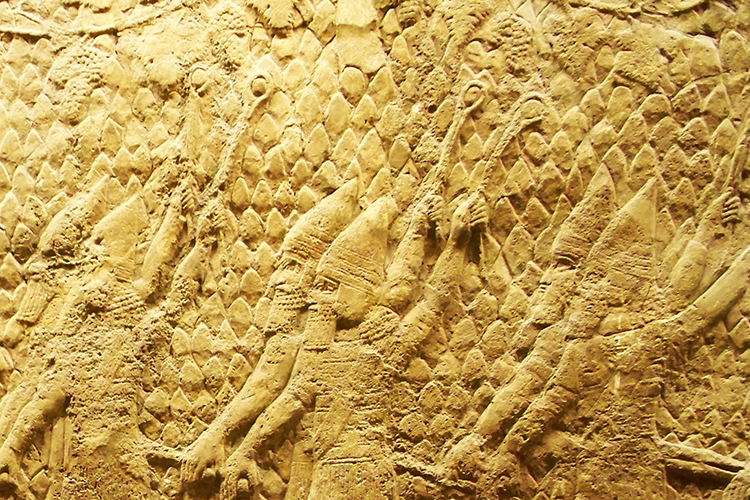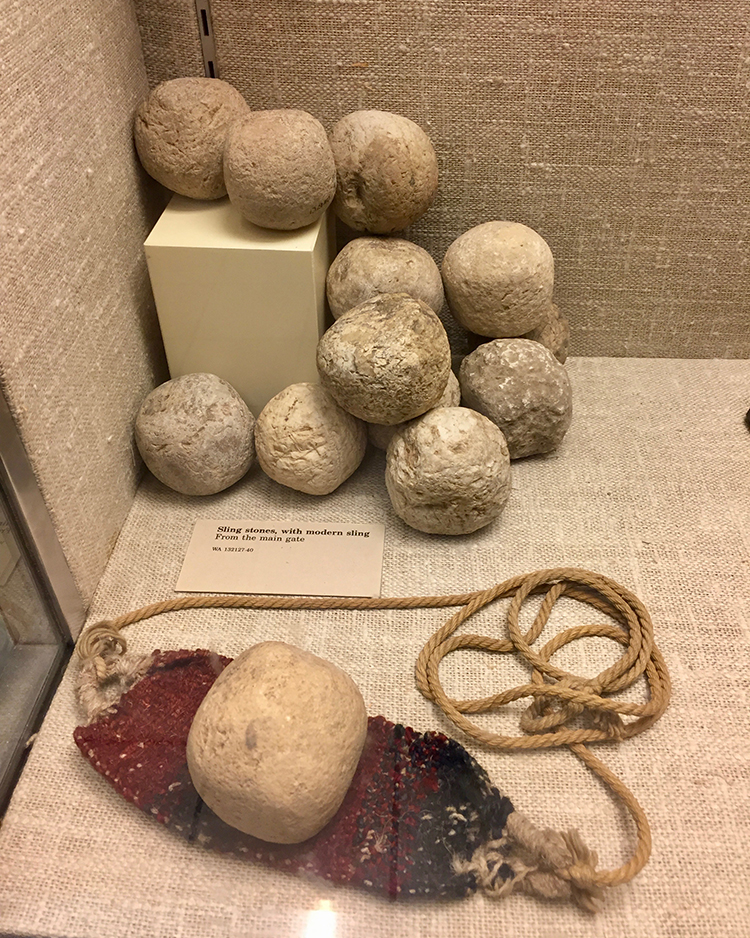

by Luke Chandler
Synopsis: "David prevailed over the Philistine with a sling and a stone, and he struck the Philistine and killed him; but there was no sword in David's hand" (1 Sam. 17:50, NASB).
Sling stones are well-known weapons from biblical times—easy and cheap to make. With a sling, these stones could be hurled at high velocity. Since ancient times, Middle Eastern shepherds have carried slings and stones to protect flocks from predators.
Slingers were ancient snipers, pelting an enemy with large-caliber rounds that impacted at up to 60 or 70 miles per hour. At this velocity, sling stones could break bones and damage weapons, creating fear and disrupting formations. Groups of slingers could concentrate on specific sections of an enemy line, creating gaps for infantry or cavalry to exploit.
The Bible mentions military units that were composed of slingers. David had a number of ambidextrous slingers among his men while living in Ziklag (1 Chron. 12:1-7). King Uzziah of Judah prepared weapons, including "stones for slinging" for his army (2 Chron. 26:14). Jehoshaphat's forces contained a corps of slingers when he attempted to put down the Moabite rebellion (2 Kings 3:25).
Details from the Benjamite War indicate how effective ancient slingers could be. A unit of 700 experienced, left-handed slingers from Benjamin helped to inflict some 40,000 casualties on the opposing Israelite forces (Judg. 20:15-25). Slinging with the left hand may have offered a tactical advantage under certain conditions since the stones would have an angle of attack toward the defenders' unshielded right side.
Enemies of Israel and Judah also utilized slingers. The Assyrian king, Sennacherib, portrays them attacking Judah in the famous "Siege of Lachish" panels that decorated his palace. The Assyrian slingers would have sniped defenders on the walls and provided covering fire for advancing infantry and siege equipment.
The best-known slinger in history is likely David, who not only showed faith and courage against Goliath but also was tactically smart. Goliath was equipped with weapons and heavy armor for close-in combat, so David turned the fight into a ranged battle with his sling. David stayed outside the range of the Philistine's long thrusting spear and fired his large-caliber stone with deadly accuracy. Ironically, this most famous of slingers substituted brook pebbles in place of properly worked sling stones (1 Sam. 17)
Sling stones are common discoveries in Mediterranean archaeology. I have personally seen more than three dozen unearthed at in the past nine years. In the Israelite period, sling stones were usually around the size of a tennis ball. Soldiers shaped them with tools to be spherical and balanced, which helped them fly straight and fully direct kinetic energy into the target upon impact. In Goliath's case, a sling stone cracked the bones in his forehead and concussed, or even damaged, his brain, causing him to collapse. Goliath was helpless when David neared to finish him off with a sword.
Archaeology provides glimpses into the history of sling technology. Centuries before Israel, Canaanite warriors sometimes battled by slinging small clay balls. We have excavated ancient walls and door frames covered with these high-velocity clay rounds, evidence of some long-forgotten battle. Archaeologists nicknamed them "Hershey's Kisses" for the way the high-speed impact altered their shape
In Greek and Roman times, soldiers upgraded from worked stones to lead bullets made in standard molds. Some Greek and Roman soldiers inscribed their sling bullets with taunts, in the same way, modern airmen write messages on bombs, which made them double as psychological weapons. Examples of sling bullet inscriptions in Greek are DEXAI ("take this")1, AIMA ("blood")2, and PAPAI ("ouch").3
Archaeology provides a sharper understanding of biblical people and events. In light of what we learn about sling stones, the story of David and Goliath emphasizes our need for wisdom. David faced his opponent with faith and courage, but he also made responsible decisions on how to act. In the same way, our faith in God must be joined with wise actions. "Look carefully how you walk, not as unwise but as wise" (Eph. 5:15, ESV).
1 Hawkins, Walter, "Observations on the Use of the Sling as a Warlike Weapon, Among the Ancients," Archaeologia 32 (1847), 104.
2 Vischer, Wilhelm, Heinrich Gelzer, Achilles Burckhardt, and August von Gonzenbach, Kleine Schriften (Leipzig: Hirzel, 1877-1878), 256.
3 Bates, William. "Two Inscribed Slingers' Bullets from Galatista." American Journal of Archaeology 34 (January-March 1930), 44.
Author Bio: Luke has worked with the North Terrace Church of Christ in the Tampa, Florida area for twelve years and has worked with archaeological expeditions in Israel for nine years. He and his wife, Melanie, have five children. His website is lukechandler.wordpress.com. He can be reached at lukechandler@verizon.net.

Image 1: Assyrian slingers on Lachish panels.

Image 2: Sling and sling stones from the British Museum.

Image 3: Laura Grace Chandler with newly excavated sling stone.